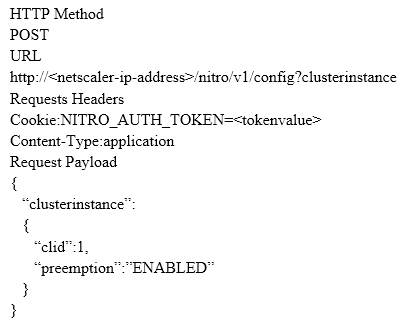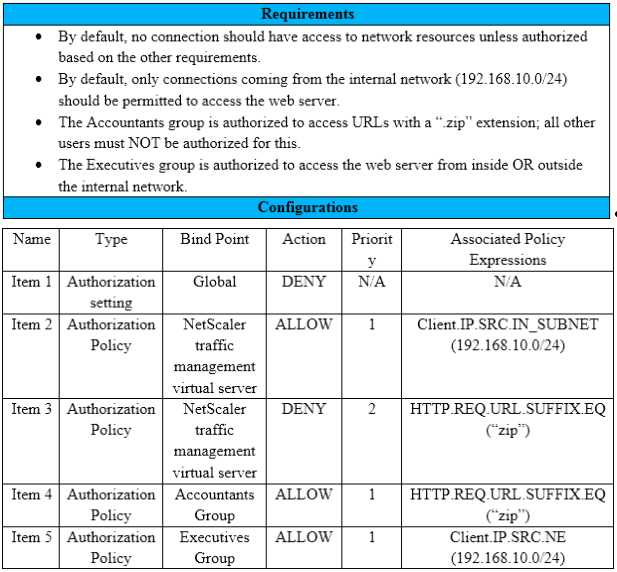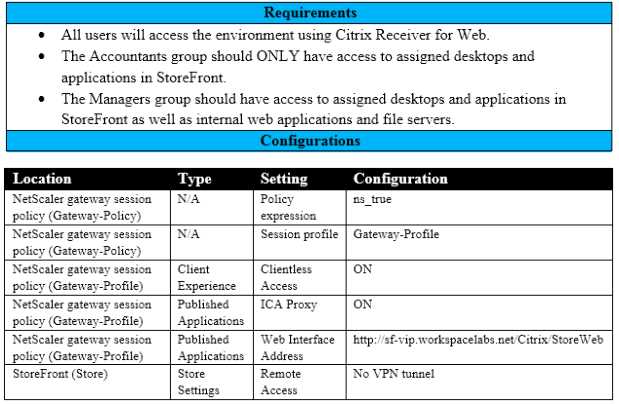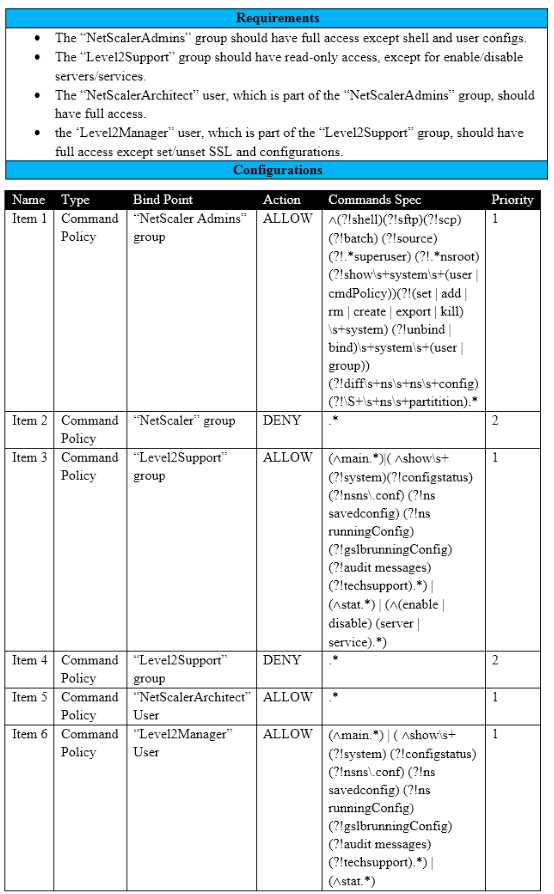Citrix 1y0-440 practice test
Architecting a Citrix Networking Solution Exam
Question 1
Scenario: A Citrix Architect has sent the following request to the NetScaler:
Which response would indicate the successful execution of the NITRO command?
- A. 302
- B. 201
- C. 202
- D. 200
Answer:
D
Question 2
Scenario: Based on a discussion between a Citrix Architect and team of Workspacelab has been
created across three (3) sites.
They captured the following requirements during the design discussion held for NetScaler design
projects:
All three (3) Workspacelab sites (DC, NDR, and DR) will have similar NetScaler configuration and
design.
Both external and internal NetScaler MPX appliances will have Global Server Load balancing (GSLB)
configured and deployed in Active/Passive mode.
GSLB should resolve both A and AAA DNS queries.
In the GSLB deployment, the NDR site will act as backup for the DC site. whereas the DR site will act
as backup for the NDR site.
When the external NetScaler replies to DNS traffic coming in through Cisco Firepower IPS, the replies
should be sent back through the same path.
On the internal NetScaler, both front-end VIP and back-end SNIP will be part of the same subnet.
USIP is configured on the DMZ NetScaler appliances.
The external NetScaler will act default gateway for back-end servers.
All three (3) sites (DC, NDR, and DR) will have two (2) links to the Internet from different service
providers configured in Active/Standby mode.
Which design decision must the architect make to meet the design requirements above?
- A. Interface 0/1 must be used for DNS traffic.
- B. The SNIP of the external NetScaler must be configured as default gateway on the back-end servers.
- C. ADNS service must be used with IPv6 address.
- D. Policy-Based Route with next hop as CISCO IPS must be configured on the external NetScaler.
Answer:
C
Question 3
Which step does a Citrix Architect need to ensure during the Define phase when following the Citrix
Methodology?
- A. Testing steps were integrated.
- B. The project manager agrees with road map timelines.
- C. A phased roll out was completed.
- D. Existing networking infrastructure is ready.
- E. The redundancy deployment decision was made.
Answer:
E
Question 4
For which three reasons should a Citrix Architect perform a capabilities assessment when designing
and deploying a new NetScaler in an existing environment? (Choose three.)
- A. Understand the skill set of the company.
- B. Assess and identify potential risks for the design and build phase.
- C. Establish and prioritize the key drivers behind a project.
- D. Determine operating systems and application usage.
- E. Identify other planned projects and initiatives that must be integrated with the design and build phase.
Answer:
B,D,E
Question 5
Scenario: A Citrix Architect needs to assess an existing NetScaler configuration. The customer
recently found that certain user groups were receiving access to an internal web server with an
authorization configuration that does NOT align with the designed security requirements.
Click the Exhibit button view the configured authorization settings for the web server.
Which item should the architect change or remove to align the authorization configuration with the
security requirements of the organization?
- A. Item 1
- B. Item 3
- C. Item 4
- D. Item 5
- E. Item 2
Answer:
E
Question 6
Scenario: A Citrix Architect needs to assess an existing NetScaler gateway deployment. During the
assessment, the architect collects key requirements for different user groups, as well as the current
session profile settings that are applied to those users.
Click the Exhibit button to view the information collected by the architect.
Which configuration should the architect make to meet these requirements?
- A. Change the Clientless Access settings in an existing session profile.
- B. Change the remote Access settings in StoreFront.
- C. Change ICA proxy settings in an existing session profile.
- D. Change the policy expression in an existing session policy.
- E. Create a new session profile and policy.
Answer:
D
Question 7
Scenario: A Citrix Architect has deployed Authentication for the SharePoint server through NetScaler.
In order to ensure that users are able to edit or upload documents, the architect has configured
persistent cookies on the NetScaler profile.
Which action should the architect take to ensure that cookies are shared between the browser and
non-browser applications?
- A. The time zone should be the same on the NetScaler, client, and SharePoint server.
- B. The SharePoint load-balancing VIP FQDN and the AAA VIP FQDN should be in the trusted site of the client browser.
- C. The Secure flag must be enabled on the cookie.
- D. The cookie type should be HttpOnly.
Answer:
B
Question 8
Scenario: A Citrix Architect has deployed an authentication setup with a ShareFile load-balancing
virtual server. The NetScaler is configured as the Service Provider and Portalguard server is utilized as
the SAML Identity Provider. While performing the functional testing, the architect finds that after the
users enter their credentials on the logon page provided by Portalguard, they get redirected back to
the Netscaler Gateway page at uri /cgi/samlauth/ and receive the following error.
SAML Assertion verification failed; Please contact your administrator.
The events in the /var/log/ns.log at the time of this issue are as follows:
Feb 23 20:35:21 <local0.err> 10.148.138.5 23/02/2018:20:35:21 GMT vorsb1 0-PPE-0 : default
AAATM Message 3225369 0 : SAML : ParseAssertion:
parsed attribute NameID, value is nameid
Feb 23 20:35:21 <local0.err> 10.148.138.5 23/02/2018:20:35:21 GMT vorsb1 0-PPE-0 : default
AAATM Message 3225370 0 : SAML verify digest:
algorithms differ, expected SHA1 found SHA256
Feb 23 20:35:44 <local0.err> 10.148.138.5 23/02/2018:20:35:44 GMT vorsb1 0-PPE-0 : default
AAATM Message 3225373 0 : SAML : ParseAssertion:
parsed attribute NameID, value is named
Feb 23 20:35:44 <local0.err> 10.148.138.5 23/02/2018:20:35:44 GMT vorsb1 0-PPE-0 : default
AAATM Message 3225374 0 : SAML verify digest:
algorithms differ, expected SHA1 found SHA256
Feb 23 20:37:55 <local0.err> 10.148.138.5 23/02/2018:20:37:55 GMT vorsb1 0-PPE-0 : default
AAATM Message 3225378 0 : SAML : ParseAssertion:
parsed attribute NameID, value is nameid
Feb 23 20:37:55 <local0.err> 10.148.138.5 23/02/2018:20:37:55 GMT vorsb1 0-PPE-0 : default
AAATM Message 3225379 0 : SAML verify digest:
algorithms differ, expected SHA1 found SHA256
What should the architect change in the SAML action to resolve this issue?
- A. Signature Algorithm to SHA 256
- B. The Digest Method to SHA 256
- C. The Digest Method to SHA 1
- D. Signature Algorithm to SHA 1
Answer:
D
Question 9
Scenario: A Citrix Architect has set up NetScaler MPX devices in high availability mode with version
12.0.53.13 nc. These are placed behind a Cisco ASA 5505 Firewall. The Cisco ASA Firewall is
configured to block traffic using access control lists. The network address translation (NAT) is also
performed on the firewall.
The following requirements were captured by the architect during the discussion held as part of the
NetScaler security implementation project with the customers security team:
The NetScaler MPX device:
should monitor the rate of traffic either on a specific virtual entity or on the device. It should be able
to mitigate the attacks from a hostile client sending a flood of requests. The NetScaler device should
be able to stop the HTTP, TCP, and DNS based requests.
needs to protect backend servers from overloading.
needs to queue all the incoming requests on the virtual server level instead of the service level.
should provide protection against well-known Windows exploits, virus-infected personal computers,
centrally managed automated botnets, compromised webservers, known spammers/hackers, and
phishing proxies.
should provide flexibility to enforce the decided level of security check inspections for the requests
originating from a specific geolocation database.
should block the traffic based on a pre-determined header length, URL length, and cookie length. The
device should ensure that characters such as a single straight quote (); backslash (\); and semicolon
(;) are either blocked, transformed, or dropped while being sent to the backend server.
Which security feature should the architect configure to meet these requirements?
- A. Global Server Load balancing with Dynamic RTT
- B. Global Server Load Balancing with DNS views
- C. Geolocation-based blocking using Application Firewall
- D. geolocation-based blocking using Responder policies
Answer:
A
Question 10
Under which two circumstances will a service be taken out of the slow start phase with automated
slow start? (Choose two.)
- A. The service does NOT receive traffic for three successive increment intervals.
- B. The server request rate parameters are set above 25 requests per second.
- C. The actual request rate is slower than the new service request rate.
- D. The percentage of traffic that the new service must receive is greater or equal to 50.
- E. The request rate has been incremented 100 times.
Answer:
A,C
Question 11
Scenario: A Citrix Architect needs to configure a full VPN session profile to meet the following
requirements:
Users should be able to send the traffic only for the allowed networks through the VPN tunnel.
Only the DNS requests ending with the configured DNS suffix workspacelab.com must be sent to
NetScaler Gateway.
If the DNS query does NOT contain a domain name, then DNS requests must be sent to NetScaler
gateway.
Which settings will meet these requirements?
- A. Split Tunnel to OFF, Split DNS Both
- B. Split Tunnel to ON, Split DNS Local
- C. Split Tunnel to OFF, Split DNS Remote
- D. Split Tunnel to ON, Split DNS Remote
Answer:
B
Question 12
A Citrix Architect needs to define the architect and operational processes required to implement and
maintain the production environment.
In which phase of the Citrix Methodology will the architect define this?
- A. Define
- B. Deploy
- C. Assess
- D. Review
- E. Manage
- F. Design
Answer:
F
Question 13
Scenario: A Citrix Architect needs to assess an existing NetScaler configuration. The customer
recently found that members of certain administrator groups were receiving permissions on the
production NetScaler appliances that do NOT align with the designed security requirements.
Click the Exhibit button to view the configured command policies for the production NetScaler
deployment.
To align the command policy configuration with the security requirements of the organization, the
_______ for ______should change. (Choose the correct option to complete the sentence.)
- A. command spec; item 3
- B. priority; Item 5
- C. action; Item 1
- D. priority; Item 2
- E. action; Item 4
- F. command spec; Item 6
Answer:
D
Question 14
Which four load-balancing methods support NetScaler Virtual Server-Level Slow Start? (Choose four.)
- A. URLHash
- B. Least response time
- C. Least Packets
- D. Least Connection
- E. Token
- F. Least bandwidth
- G. SRCIPSRCPORTHash
Answer:
B,C,D,F
Question 15
Scenario: A Citrix Architect needs to deploy a NetScaler appliance for Workspacelab, which will
provide application load balancing services to Partnerlab and Vendorlab.
The setup requirements are as follows:
A pair of NetScaler MPX appliances will be deployed in the DMZ network.
High availability will be accessible on the NetScaler MPX in the DMZ Network.
Load balancing should be performed for the mail servers for Partnerlab and Vendorlab.
The traffic for both of the organizations must be isolated.
Separate Management accounts must be available for each client.
The load-balancing IP addresses must be identical.
A separate VLAN must be utilized for communication for each client.
Which solution can the architect utilize to meet the requirements?
- A. Traffic Domain
- B. Admin Partition
- C. VLAN Filtering
- D. VPX or MPX
Answer:
D